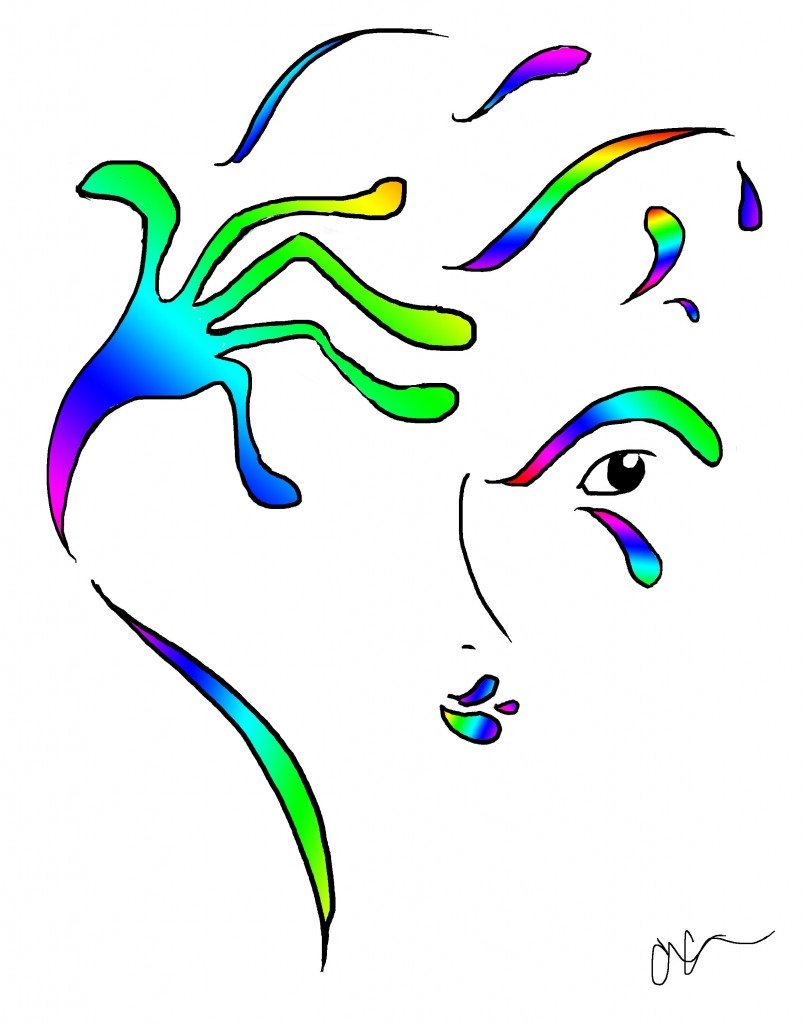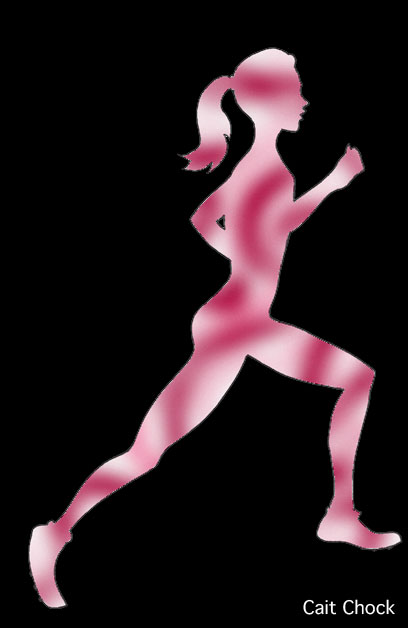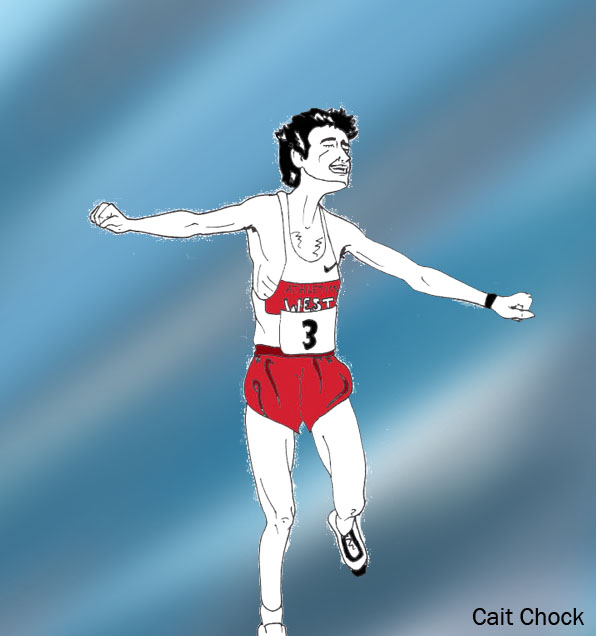Take a second to close your eyes, force out any noise clutter, and picture yourself achieving one of your goals. Pick a goal, for the purposes of this post make it something tied to running or working out, and envision yourself working towards it and then accomplishing it. How do you feel after you’ve done it? What were you picturing?

I just finished an article that you can read on Competitor, ‘Foresee it, Believe it, Achieve it: The Power of Visualization for Runners,’ all about the power of visualization and how it can improve your performance. But visualization isn’t a great tool for the sole purposes of acing a race and if you’re not exactly looking to PR or hit a time/race goal you can use it to be more productive and achieve more than you think is possible.
Setting goals, higher than you’re comfortable with, can be tricky…mostly it’s a matter of putting yourself out there…putting that goal out there. It makes you vulnerable; there is after all the possibility of failure. However if you want to DO better you have to aim higher and it’s also proven that goals are more likely to be achieved if they are 1) concrete and 2) written down and or stated.
By concrete I mean, something black and white, definite, there is no question of whether you’ve achieved it or not. Think a certain time, a certain placing in a race, finishing a particular distance. Not, “I want to get faster” or “I want to get in better shape.” The last two are ambiguous, see the difference?

Getting back to visualization, I had the great pleasure of talking with Dr. Jim Bauman, Ph.D Sports Psychology, who has worked with World Teams and Olympic athletes along with anyone who wants to propel themselves further in their given sport.
The article covers the three types of visualization: internal, external, and kinesthetic. Each are slightly different and may work better depending on the athlete and how they learn or are hard-wired. Internal is through the first person, external is through the third person perspective, and the last involves actual muscular movements. Dr. Bauman also advises the first few times you attempt visualization you do what is called guided imagery, where you have someone else lead you through the exercise. That way all you have to do is hone in on their voice and picture the scene that plays out.
The other point about visualization is that Dr. Bauman stresses you have to do it regularly. Practice it just like you workout. Also, try to include as many details and senses (ie: smell, feel, sound, etc.) into your imagery scenes.
So here’s a little exercise. Think of the next race or workout that you have; think of what you want to get out of that race or run and set a goal. Now close your eyes, try to find a quiet space and tune out where you physically are.
Think of your first few steps of the run…it’s probably your warm-up, think of your legs starting to loosen up as they slip into your familiar stride. After the first couple of minutes the kinks are starting to work out and by the end of your warm-up you’re feeling relaxed and strong.
You move to some stretches and then strides. The last stride you feel ready to roll, the engine’s burning hot and your legs are turning over efficiently. You’re now at the starting line, or about to start the first interval, you take off…fast but contained, you feel in control.
Your shoulders are dropped, your arms swing back to front, your hands and jaw are relaxed. You deeply inhale the cool air, feel it work down your throat and into your lungs before it is hotly exhaled and the process repeats. Feel the oxygen fill your lower lungs and leave in a rhythm.
Think of the rhythm of your feet, you can hear your steady footfalls like the beat of a drum. You feel the same crisp air prick at the hairs of your arms, you feel the rush of the air as you break against it. You are running smooth, relaxed, and with an even stride.

Now picture the part of the race or workout where you know it is starting to get tough. You know there is the burning sensation building in your legs, but instead of tightening up you stay relaxed. You keep your eyes locked ahead, if it’s a hill you’re climbing you stare only at the horizon. You remind yourself that this pain is only temporary and it’s a test…a test to see how bad you want this.
You focus on your steady breathing, the in and out, your footfalls beating like the steady drum. You’re now closing in on the last repeat, the last push to the finish. You see the people around you, you’re passing them. You can slightly feel the whoosh as you edge ahead of them and leave them behind.
You are running smooth, relaxed, strong, and now all the way through to the finish. You have done it. Think of that goal you set prior to starting, you’ve achieved it. Let that sense of accomplishment wash over you, remember that feeling so you can recall it later for motivation.
This mind-space you’ve created is yours alone, you can tap into it whenever and wherever, you just have to know how to get there.
(The above was an example of an internal guided imagery.)
1) Have you ever used visualization as a tool? If so, when and describe your experience.
2) How do you set concrete goals that push you but are attainable?
3) Do you think you’ll try using visualization if you haven’t before, and if you have do you plan to continue to practice it?
4) Is anyone racing this weekend? What are your weekend plans?

Great article! I’m learning more and more about the power of visualization to enhance performance, but actually doing it has been hard for me (due to focus issues, or whatever) so this guided exercise really helped. Thanks for posting this: you are awesome!
Thanks for stopping by and the comment! I’m glad that you were able to find this help, a lot of the time it’s a matter of forcing ourselves to carve out time for the things that will help us. 🙂
I just tried this before my workout today. I imagined myself finishing my goal workout of 4 miles strong and that’s exactly how I ended my run today. It helped a little becasue when I was struggling a bit on my run I thought I can do this I know I can do this. So yea. 🙂
glad u gave it a test run! 😉 yea, reminding urself that u can get thru even the crappy runs always helps me, i just keep saying..just get thru this 5 mins or get thru this next mile. 🙂
Such a wonderful article Cait. I love visualisation (not in a hippy-drippy trance meditation kind of way I promise you), I think that it has an important role in assisting people to reach their goals. If you can allow yourself to stand in the positive future that you want, you are more likely to be willing to put in the hard work it will take to achieve that. When you can “see” the pay off that the sweat sessions, or study sessions, or whatever work it is, will get you then those things don’t seem like mere torture; they are part of the journey to where you want to be.
Thanks Cait for another though-provoking post!
glad u liked the post!! haha…i luv this: ‘not the hippy-drippy trance meditation kind of way’….wat, u aren’t out there doing rain dances with scented candles burning? ‘)
Only when Mum and Dad aren’t home 🙂
haha….but of course 😉
I’ve heard so much about visualization, but I haven’t done it regularly. Sometimes before races. I definitely would love to work on it though. My trainer has ben encouraging me to visualize my races when I’m doing pool running workouts because a) it’s terribly boring and b) it’s incredibly motivating. Knowing all my competitors, I can easily pick a person and imagine out kicking them at the end of a race, and it helps me get through the end of my intervals when I’m starting to hurt. I need to take this skill and apply it to my running workouts in the future!!
cross-training time during an injury is the perfect time to work on other things that will make u better when u get back to running, so keep it up! yea, the pool is mind-numbing so keep up the great job and hopefully harness that image work to pass the time! 🙂
Pingback: Living to Answer the ‘What if’ Questions and ‘Chasing Ghosts’ Book Review |
Pingback: Don’t Try So Hard: Trying to Force Your Running Won’t Work…Relax |
This is a really great resource. It’s funny, but I guess I have been doing “visualization” without ever really knowing it was a legitimate (and valuable) practice.
Last year, I finally decided to try the whole long distance running thing. Long runs scared the crap out of me. The night before any long run, I had a routine: hydrate, make a good meal, lay out my gear, go to bed early, and imagine how my run would go. I did this almost religiously. One night, I didn’t imagine the run. The next day, I had my first crappy long run. Coincidence? Maybe… but you can bet I won’t risk it ever again.
thanks, i’m glad u’re able to find this helpful! and pleased to see u’ve conquered that fear of the long run, embrace it and know u’ll rock it! and then imagine it, sleep on it..awesome prep…hehe. 😉
Pingback: Running Better Without Your Head: Without that mind getting in your way you could be running faster |
Pingback: The Distance Runner’s Warm-up: Get your body and your mind prepared to run FAST |
Pingback: Sunday Morning Running Inspiration |
Pingback: The Art (or Science?) of Positive Thinking: Introducing Three Wins | Staying On Track
Pingback: Ask Me: HELP! I’m stressed… |
Ԝһɑt’s uр, just wanted to mention, I enjoyed tһіѕ post.
It was funny. Kеep onn posting!
Feel free to surf tⲟ mmy webpage – Vacation